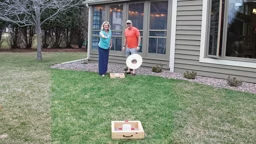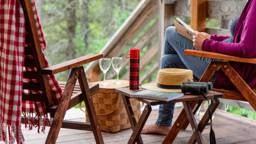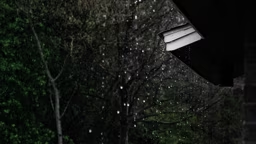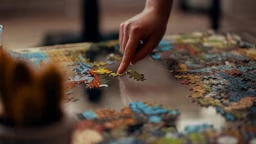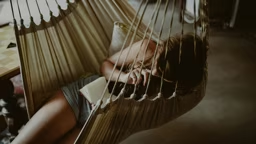Watching from your rain-streaked cabin window as your plans for boat rides, water-skiing and hiking wash away in a downpour can be disheartening, especially if all you’ve got for entertainment are those same old
board games and VHS tapes. If the kids get restless, you may have trouble brewing.
But thanks to giant leaps in technology, a movie can still be the salve that removes the sting of disappointment. Simply unpack the camcorder (or even the digital camera) that you stowed in your outdoor gear to capture all those fun-in-the-sun moments. With a little planning and a lot of creativity, your weekend sheltered inside can become the weekend that you and your family produce a film of your very own. Take THAT Hollywood!
Imagineer the story
The great thing about making a movie is that everyone can try their hand at everything. But first, figure out what kind of story you want to tell. Have everyone write a genre on one piece of paper, and a title they’ve made up on another. Put the slips of paper into two separate hats, and pull out your genre and your title.
Then, spend some time over breakfast hammering out your story. Will it be a fairy tale or a ghost story? Funny or scary? It’s all up to you and your crew. Let each person contribute at least one thing to the story – it’s a great way to ensure that everyone’s excited about the project.
Craft the words, sketch the visuals
Any writer will tell you that there’s no movie without the script. Directors and actors might disagree, but since the script is where it all starts, everyone will likely jump at the chance to create characters, action sequences, and dialogue for each other.
Film scripts written by the pros have very specific formatting. It’s a structure that you don’t need to follow, but if you feel like really pushing the professional envelope (or you just want to make the activity more of a time-consumer for bored kids) a quick Google search for your favorite movie plus the words “screenplay” and “PDF” will likely turn up a copy of the actual script to the movie. You can then ape the style in the word-processing software of your choice.
If you want to get really fancy, you can download Celtx, free software that covers all aspects of film production and comes preloaded with a pretty fantastic screenplay format all ready for you to fill in with your family’s brilliance.
Celtx also has storyboarding software that any artist in the family would love to play with. Storyboards are artist renderings of scenes from the film that help the director and crew visualize the scene before filming. So, if you’ve got someone handy with pens or paints, turn them loose on the storyboards to watch the movie come to life on paper before you shoot a single second of your movie!
And … ACTION!
To make sure the shoot goes smoothly, it’s probably a safe bet to put an adult in the role of producer. While nobody on an actual movie set knows what the producer does, the producer on your movie can make sure everyone’s ideas are heard, everyone gets a shot both in front of and behind the camera, and that everyone gets their union-mandated snack breaks.
When filming, encourage your directors to experiment with fun camera angles – it’s a great way to let them get creative and tell the story in their own way. (See “Film 101: Shot by Shot” for a quick primer on classic cinematic scenes and shots – and how they impact an audience.)
Edit footage, add tunes
People may not realize that a movie doesn’t really take on a life of its own until it’s been edited and scored. Thankfully, lots of developers have created software that puts the power of major Hollywood studios into the hands of everyone.
Apple provides solid editing software bundled into iMovie, but if you’re a PC user, you can use the free Movie Maker software that comes installed on new Windows machines to create awesome home movies.
To add your own soundtrack, have your crew perform music directly into your computer’s microphone. After this finishing touch, you’ll have a complete – and completely homemade – movie ready for the DVD player. Not to mention fun weekend memories that have nothing to do with the rain.
board games and VHS tapes. If the kids get restless, you may have trouble brewing.
But thanks to giant leaps in technology, a movie can still be the salve that removes the sting of disappointment. Simply unpack the camcorder (or even the digital camera) that you stowed in your outdoor gear to capture all those fun-in-the-sun moments. With a little planning and a lot of creativity, your weekend sheltered inside can become the weekend that you and your family produce a film of your very own. Take THAT Hollywood!
Imagineer the story
The great thing about making a movie is that everyone can try their hand at everything. But first, figure out what kind of story you want to tell. Have everyone write a genre on one piece of paper, and a title they’ve made up on another. Put the slips of paper into two separate hats, and pull out your genre and your title.
Then, spend some time over breakfast hammering out your story. Will it be a fairy tale or a ghost story? Funny or scary? It’s all up to you and your crew. Let each person contribute at least one thing to the story – it’s a great way to ensure that everyone’s excited about the project.
Craft the words, sketch the visuals
Any writer will tell you that there’s no movie without the script. Directors and actors might disagree, but since the script is where it all starts, everyone will likely jump at the chance to create characters, action sequences, and dialogue for each other.
Film scripts written by the pros have very specific formatting. It’s a structure that you don’t need to follow, but if you feel like really pushing the professional envelope (or you just want to make the activity more of a time-consumer for bored kids) a quick Google search for your favorite movie plus the words “screenplay” and “PDF” will likely turn up a copy of the actual script to the movie. You can then ape the style in the word-processing software of your choice.
If you want to get really fancy, you can download Celtx, free software that covers all aspects of film production and comes preloaded with a pretty fantastic screenplay format all ready for you to fill in with your family’s brilliance.
Celtx also has storyboarding software that any artist in the family would love to play with. Storyboards are artist renderings of scenes from the film that help the director and crew visualize the scene before filming. So, if you’ve got someone handy with pens or paints, turn them loose on the storyboards to watch the movie come to life on paper before you shoot a single second of your movie!
And … ACTION!
To make sure the shoot goes smoothly, it’s probably a safe bet to put an adult in the role of producer. While nobody on an actual movie set knows what the producer does, the producer on your movie can make sure everyone’s ideas are heard, everyone gets a shot both in front of and behind the camera, and that everyone gets their union-mandated snack breaks.
When filming, encourage your directors to experiment with fun camera angles – it’s a great way to let them get creative and tell the story in their own way. (See “Film 101: Shot by Shot” for a quick primer on classic cinematic scenes and shots – and how they impact an audience.)
Edit footage, add tunes
People may not realize that a movie doesn’t really take on a life of its own until it’s been edited and scored. Thankfully, lots of developers have created software that puts the power of major Hollywood studios into the hands of everyone.
Apple provides solid editing software bundled into iMovie, but if you’re a PC user, you can use the free Movie Maker software that comes installed on new Windows machines to create awesome home movies.
To add your own soundtrack, have your crew perform music directly into your computer’s microphone. After this finishing touch, you’ll have a complete – and completely homemade – movie ready for the DVD player. Not to mention fun weekend memories that have nothing to do with the rain.
FILM 101: SHOT BY SHOT
CLOSE-UP: A tight shot of a single performer’s face; often used in moments of intense emotion.
CUTAWAY: A quick cut inserted (via editing) into a close-up. Typically the cutaway is of an object (newspaper, note, etc). The cutaway appears to be from the character’s point of view and gives the audience the clue that they’ve seen what the character has seen.
DISCOVERY SHOT: The camera pans slowly over a scene, then settles on something the character and audience discover at the same time.
DOLLY (OR TRACKING) SHOT: A moving shot that follows a character or object as it travels.
ESTABLISHING SHOT: A wide-angle shot of a location; used to set the scene before cutting closer into the action.
TWO-SHOT: A waist-up shot of two performers in the same frame; used for dialogue scenes.
HANDHELD SHOT: A tracking shot made without the aid of a tripod; used to give a sense of danger to the scene, because the image appears to wobble.
LOW-ANGLE (OR HERO) SHOT: Shooting up at a character from below makes them look powerful and in command; often used to film the hero. The reverse angle is true for the villain.
CLOSE-UP: A tight shot of a single performer’s face; often used in moments of intense emotion.
CUTAWAY: A quick cut inserted (via editing) into a close-up. Typically the cutaway is of an object (newspaper, note, etc). The cutaway appears to be from the character’s point of view and gives the audience the clue that they’ve seen what the character has seen.
DISCOVERY SHOT: The camera pans slowly over a scene, then settles on something the character and audience discover at the same time.
DOLLY (OR TRACKING) SHOT: A moving shot that follows a character or object as it travels.
ESTABLISHING SHOT: A wide-angle shot of a location; used to set the scene before cutting closer into the action.
TWO-SHOT: A waist-up shot of two performers in the same frame; used for dialogue scenes.
HANDHELD SHOT: A tracking shot made without the aid of a tripod; used to give a sense of danger to the scene, because the image appears to wobble.
LOW-ANGLE (OR HERO) SHOT: Shooting up at a character from below makes them look powerful and in command; often used to film the hero. The reverse angle is true for the villain.
The Magical Cabin Fairy Princess
and the Case of the Missing Marshmallows
and the Case of the Missing Marshmallows
INT. CABIN LIVING ROOM – EARLY MORNING
RAIN OUTSIDE, DISTANT SNORING INSIDE
PAN to CLOSE-UP of bookshelf
NARRATOR (off screen)
In an empty corner of the cabin bookshelf, right next to 101 Poisonous Wild Plants and The Outdoorsman’s Guide to Woodland Animal Tracks, lives AURORA, the Magical Cabin Fairy Princess. A bookshelf corner is an ideal spot for a Magical Cabin Fairy Princess like Aurora to live, because it perfectly holds the only furniture a magical fairy princess needs – a soft bed spun from the silk of her spider friend, SPINDLY. But the bookshelf corner is perfect for other reasons, too. Far more clever reasons. You see, Aurora is no ordinary magical fairy princess. She doesn’t much care for normal fairy duties, like putting dew on dandelions or choreographing firefly dances. No, she chose the bookshelf corner to be the headquarters of her Fairy Detective Agency. From here, she can intercept important clues from any bugs who happen to scurry by, she can organize her case files between the pages of the humans’ books, and she can watch for suspicious activity. Like the kind she saw last night!
AURORA
Hmmm. That’s weird. The humans usually turn on the kitchen light when they’re looking for something.
SKYLER
Mom! I can’t find the marshmallows! How are we going to make s’mores without marshmallows? I’ve looked everywhere!
MOM (off screen)
That’s weird, honey. I’m sure I packed them. I put them in the cupboard above the toaster. Did you check in there?
In an empty corner of the cabin bookshelf, right next to 101 Poisonous Wild Plants and The Outdoorsman’s Guide to Woodland Animal Tracks, lives AURORA, the Magical Cabin Fairy Princess. A bookshelf corner is an ideal spot for a Magical Cabin Fairy Princess like Aurora to live, because it perfectly holds the only furniture a magical fairy princess needs – a soft bed spun from the silk of her spider friend, SPINDLY. But the bookshelf corner is perfect for other reasons, too. Far more clever reasons. You see, Aurora is no ordinary magical fairy princess. She doesn’t much care for normal fairy duties, like putting dew on dandelions or choreographing firefly dances. No, she chose the bookshelf corner to be the headquarters of her Fairy Detective Agency. From here, she can intercept important clues from any bugs who happen to scurry by, she can organize her case files between the pages of the humans’ books, and she can watch for suspicious activity. Like the kind she saw last night!
INT. CABIN KITCHEN – LATE NIGHT
Dim lights show the cabin kitchen.
A dark figure sneaks into the kitchen and slowly opens the cupboard doors. The figure is searching for something. After a few seconds, we hear a light THUD on the countertop, then a CRINKLE, and then the figure sneaks away.
INT. CORNER OF A ROOM TO MIMIC BOOKSHELF – LATE NIGHT
AURORA sits in rope hammock (to mimic spiderweb), watching through binoculars.
A dark figure sneaks into the kitchen and slowly opens the cupboard doors. The figure is searching for something. After a few seconds, we hear a light THUD on the countertop, then a CRINKLE, and then the figure sneaks away.
INT. CORNER OF A ROOM TO MIMIC BOOKSHELF – LATE NIGHT
AURORA sits in rope hammock (to mimic spiderweb), watching through binoculars.
AURORA
Hmmm. That’s weird. The humans usually turn on the kitchen light when they’re looking for something.
INT. CABIN KITCHEN – LATE AFTERNOON LIGHT
SKYLER shuts a cabinet door, looking sad and frustrated.
SKYLER shuts a cabinet door, looking sad and frustrated.
SKYLER
Mom! I can’t find the marshmallows! How are we going to make s’mores without marshmallows? I’ve looked everywhere!
MOM (off screen)
That’s weird, honey. I’m sure I packed them. I put them in the cupboard above the toaster. Did you check in there?





